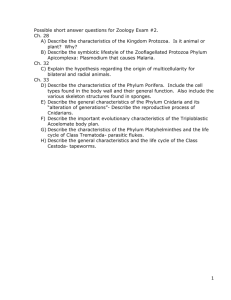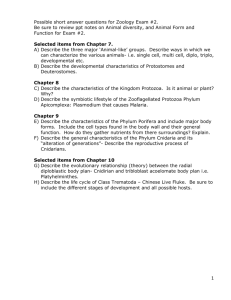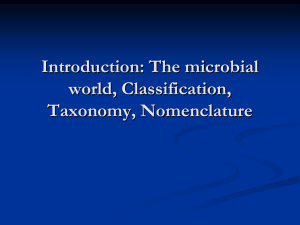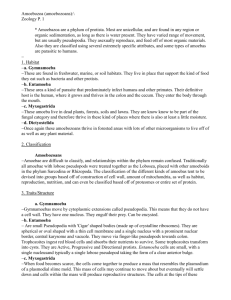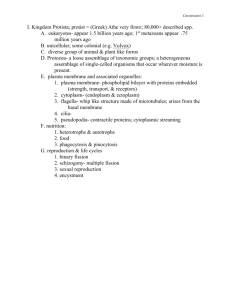Intestinal parasites Introduction These notes are a guide to the
advertisement
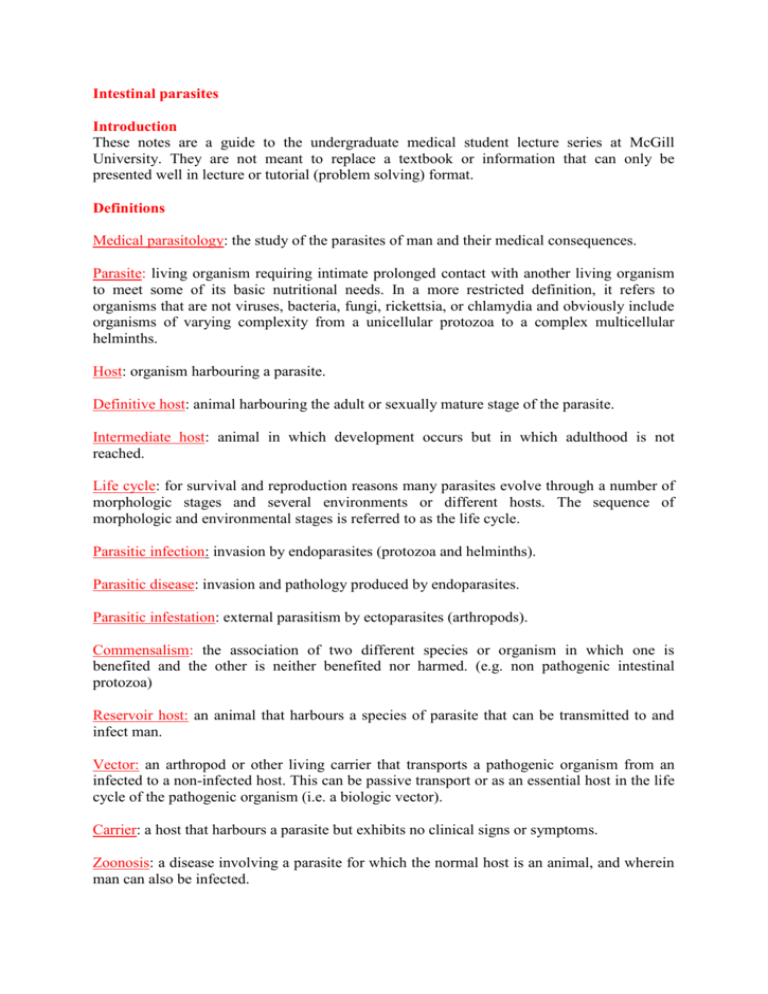
Intestinal parasites Introduction These notes are a guide to the undergraduate medical student lecture series at McGill University. They are not meant to replace a textbook or information that can only be presented well in lecture or tutorial (problem solving) format. Definitions Medical parasitology: the study of the parasites of man and their medical consequences. Parasite: living organism requiring intimate prolonged contact with another living organism to meet some of its basic nutritional needs. In a more restricted definition, it refers to organisms that are not viruses, bacteria, fungi, rickettsia, or chlamydia and obviously include organisms of varying complexity from a unicellular protozoa to a complex multicellular helminths. Host: organism harbouring a parasite. Definitive host: animal harbouring the adult or sexually mature stage of the parasite. Intermediate host: animal in which development occurs but in which adulthood is not reached. Life cycle: for survival and reproduction reasons many parasites evolve through a number of morphologic stages and several environments or different hosts. The sequence of morphologic and environmental stages is referred to as the life cycle. Parasitic infection: invasion by endoparasites (protozoa and helminths). Parasitic disease: invasion and pathology produced by endoparasites. Parasitic infestation: external parasitism by ectoparasites (arthropods). Commensalism: the association of two different species or organism in which one is benefited and the other is neither benefited nor harmed. (e.g. non pathogenic intestinal protozoa) Reservoir host: an animal that harbours a species of parasite that can be transmitted to and infect man. Vector: an arthropod or other living carrier that transports a pathogenic organism from an infected to a non-infected host. This can be passive transport or as an essential host in the life cycle of the pathogenic organism (i.e. a biologic vector). Carrier: a host that harbours a parasite but exhibits no clinical signs or symptoms. Zoonosis: a disease involving a parasite for which the normal host is an animal, and wherein man can also be infected. Protozoa: a subkingdom consisting of unicellular eukaryotic (Greek-karyon=nut=nucleus) animals. Eukaryote: a cell with a well-defined chromosome in a membrane bound nucleus. (versus prokaryotic bacteria with nucleic acid material bound in a nuclear membrane). World annual rates of morbiditv and mortality Protozoa Nematodes Trematodes Cestodes malaria amoeba toxoplasma trypanosoma intestinal nematodes filaria onchocerca schistosoma tapeworms Infections (millions) 800 480 24 Disease (millions) 150 50 40 1.2 Deaths (thousands) 1500 100 10 60 2400 2.6 80 250 30 200 2.5 3 5 20 <1 50 1000 Taxonomy CLASSIFICATION Kingdom Subkingdom Phylum Subphylum Subphylum Phylum Phylum Phylum CLASSIFICATION Kingdom Subkingdom Phylum Phylum Class Class NAME Animalia Protozoa Sarcomastigophora Sarcodina Mastigophora Apicomplexa Ciliophora Microspora NAME Animalia Metazoa Nematoda Platyhelminthes Cestoidea Trematoda EXAMPLE GENUS Entamoeba Giardia Plasmodium (malaria) Balantidium Enterocytozoan (microsporidium) EXAMPLE GENUS Ancylostoma (hookworm) Taenia (tapeworm) Clonorchis (liver fluke) Phylum Arthropoda Anopheles mosquito) (malaria vector . Intestinal Protozoa OVERVIEW The following areas of knowledge are suggested as especially important for the beginner. -biology: systematics, structural and motility features - pathogenesis: in small intestine of Giardia, Microsporidia, Cryptosporidia, Cyclospora in large intestine of : Entamoeba histolytica - epidemiology: zoonoses, carrier states, fecal-oral transmission - clinical features: acute, chronic, asymptomatic carrier states, opportunism in the immunocompromised - diagnosis: stool examination, stains, transport preservatives - treatment: metronidazole, diodoquine, trimethoprim/sulfa - problems: drug resistance; pathogenesis; laboratory identification Taxonomy The classification of the medically important parasites is as follows (ref. Beaver-Clinical Parasitology 1984) within the kingdom "Animalia". Subkingdom Protozoa: 45,000 unicellular species, each defined in the phylum according to organelles, locomotion, life cycle and type of reproduction. Phylum Sarcomastigophora. Subphylum - Mastigophora: movement with flagella - e.g. Trichomonas, Giardia Subphylum - Sarcodina: pseudopodia, e.g. amoeba Phylum Apicomplexa: apical complex, no locomotor apparatus; sexual reproduction, e.g. malaria, Isospora, Toxoplasma Phylum Ciliophora: movement with cilia, e.g. Balantidium. Phylum Microspora: e.g. Enterocytozoon trophozoites cysts Sarcodina Ciliophora Mastigophora Apicomplexa Microspora eg eg. eg. eg eg E. Balantidium Giardia Cyclospora Enterocytozoon histolytica Subkingdom-Metazoa multicellular organisms. Phylum-Nematoda: round worms, round in cross section; separate sexes; complete digestive tract; 500,000 species only a few parasitic to man; e.g. hookworm., filaria Phylum - Platyhelminthes: flat worms; incomplete or absent digestive tract; no body cavity ; mostly hermaphroditic. Class Trematoda: flukes; leaf shaped unsegmented body, often complex life cycle; e.g. lung fluke. Class Cestoidea: tapeworms; segmented bodies each segment containing complete set of male and female reproductive organs; no alimentary tract, nutrition by absorption through body wall. e.g. beef tape worm. PROTOZOA There are 45,000 species of protozoa. A small number are parasites of man, some pathogenic and others non-pathogenic (commensals). The life cycles of the protozoa vary from simple binary fission (e.g. Entamoeba histolytica) in one host to a complicated sequence of morphologic transformations through several hosts (intermediate and definitive) e.g. malaria. The biology of the organism, pathogenesis of disease and epidemiology will be discussed with emphasis on the common or representative organisms. A taxonomic approach to classification is of biological importance but a clinical classification is useful for the physician. Taxonomic or Clinical Taxonomy Mastigophora Clinical Intestinal protozoa (eg amoeba, Giardia) Sarcodina Apicomplexa Ciliophora Microsporidia Tissue protozoa Blood protozoa (eg Toxoplasma) (eg malaria) Intestinal protozoa The important intestinal protozoa that infect man fall within the following 5 catagories: Sarcodina: Entamoeba histolytica** (**=pathogenic) Entamoeba dispar Iodomoeba butschlii Dientamoeba fragilis** Endolimax nana Entamoeba coli Entamoeba hartmani Apicomplexa: Cryptosporidium parvum.** Isospora belli ** Cyclospora cayetanensis** Mastigophora: Giardia lamblia** Trichomomas hominis Chilomastix mesnili Ciliophora: Balantidium coli** Microsporidia: Enterocytozoon bienusi** Only eight have been shown to be pathogenic and therein lies a major problem. Some significant expertise is required to diagnose the genus or species of the protozoan in a laboratory specimen; lacking this, diagnoses are very difficult. The characteristics important to the clinical parasitology microscopist include nuclear shape and size, chromatin distribution, the micrometer measured size of the protozoan, intracellular organelles and locomotion. Entamoeba histolytica E. Subphylum: Sarcodina histolytica trophozoite with ingested RBCs E. histolytica trophozoite Biology: Two morphological stages occur Trophozoite - metabolically active invasive stage, moves with pseudopodia, ingests RBC, lives in colon and is found in fresh diarrheal stool; divides by binary fission. - trophozoite 10-60 µm - cogwheel distribution of nuclear chromatin - hematophagous - unidirectional movement with pseudopodia Cyst - "vegetative" inactive form resistant to unfavourable environmental conditions outside human host; - 4 nuclei - this is the infective form resistant to stomach acid if swallowed - survives up to 30 days; excyst to trophozoite on passing through stomach - cyst 10-20 µm - chromotoidal body Pathogenesis: - Digests (liquifies) human host cells (colon wall, neutrophils, liver cells) Disease states: - asymptomatic carrier- symptomatic infection - amoebic dysentery - mucoid bloody - amoebic - liver or lung abscess Diagnosis: - stool examination - for trophozoites and cysts - amoebic serology - abscess aspirate - Entamoeba dispar a non-pathogen is indistinguishable by microscopy and is a much more common intestinal protozoan than Entamoeba histolytica. Antigen capture and PCR tests can distinguish E. dispar from E. histolytica in heavier infections. Treatment: Invasive states (Dysentery, Liver abscess): metronidazole Carrier states: diiodoquine, diloxanide furoate, or paromomycin Giardia lamblia Subphylum: Mastigophora Biology: - occurs as both a flagellated trophozoite and a non-flagellated cyst form - trophozoite (9-21 µm long), motile, with 8 long flagella, ventral sucker which attaches to duodenal mucosa; lives only in small intestine; non invasive. - cyst (8-12 µm); resistant to external environment, to municipal chlorination; intermittently expelled in stool. Giardia trophozoites Giardia cyst http://www.dpd.cdc.gov/dpdx/HTML/ImageLibrary/Giardiasis_il.htm Epidemiology: - faecal oral spread - prevalence about 3-5% in Canada; increased in some travelers, backpackers, institutions, day cares and any groups with increased fecal-oral spread. - zoonosis - found in most mammals; esp. beaver, cattle, cats, dogs, etc. Pathogenesis: - mechanism unknown; toxin? host immunity? Giardia trophozoites in small intestine - more common in IGA deficient - some immunity occurs post infection - pathology: villus atrophy and crypt hyperplasia Clinical: - 90% of infected are asymptomatic carriers - acute giardiasis includes diarrhea, gas, anorexia for 1-2 weeks - chronic giardiasis - diarrhea, malabsorption Diagnosis: - stool examination - duodenal fluid (aspirate or string test) - giardia antigen detection in stool Treatment: - metronidazole, atabrine.
